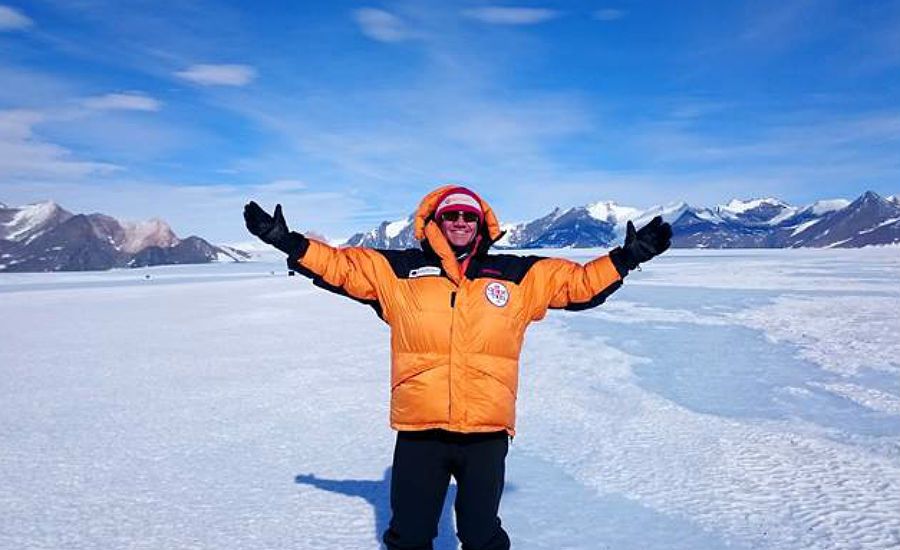In 2002, Sean Swarner became one of small group of people to successfully climb Mount Everest. More astonishing than that: Swarner scaled the tallest peak in the world with only one lung.
Though Everest is an obstacle course that could bring any climber to their breaking point—– freezing temperatures, risk of frostbite, avalanches, high winds and low levels of oxygen—28-year-old Swarner had already survived another beast—cancer—twice, before he’d even reached 18 years old. Being the first cancer survivor to stand at the “top of the world,” made his victory that much sweeter. Swarner’s survival story begins when he was 13. He injured his knee playing basketball with some friends and hours later every joint in his body was swollen. His parents rushed him to the hospital. Days passed, the swelling only got worse. After multiple blood tests and visits with an oncologist, Swarner was diagnosed with Hodgkin’s Disease, a cancer of the lymph system.
His body riddled with cancer, Swarner had to undergo a year of chemotherapy — two to three treatments a week — that left him in a constant state of nausea, and caused him to lose his hair and gain weight.
“If the cancer wasn’t going to kill me the treatments were,” Swarner tells Guideposts.org.
Miraculously, Swarner went into remission. But that, unfortunately, was not the end of his teenage cancer battle.
When he was 16, Swarner faced an even bigger challenge. Doctors told him he had something called Askin’s Sarcoma after a routine exam showed a tumor in his lung. A rare cancer – only three out of a million people are diagnosed each year – this one was even more deadly than Hodgkins Disease, with a survival rate of just six percent.
The aggressive disease called for aggressive treatment. Swarner would face four day radiation cycles where he would undergo treatment, recover and then begin the process again. It took such a toll on his body that doctors put him in a medically induced coma for those days, so that he didn’t remember the devastating side effects of the chemo. This went on for a year and a half.
“I barely remember being 16,” he admits. “I’ll go visit a hospital now and I’ll smell something that brings back a flood of memories I didn’t know I had. It’s really scary sometimes.”
Facing death not once but twice would cause most people feelings of anger, frustration, even depression. Swarner said he felt all of that, but one emotion trumped them all.
“The way I saw it was I only have two choices: fight for my life or give up and die,” he says. “What’s the logical choice? Well, for me at least, I’m not going to just sit there and tap on my chest and say ‘All right, I’m done.’”
Swarner beat his second bout with cancer, though the treatments and the tumor cost him a lung – if you’ve ever watched the movie Finding Nemo, you’ll laugh when he explains why he calls it his “lucky lung.”
With cancer behind him, Swarner wanted to use his life to inspire others facing the same battles he’d gone through. An eye-opening trip to Guatemala climbing El Volacano de Agua gave him an idea.
“I wanted to do something that no survivor had ever done before,” he explains. “I kept doing research and it was like, ‘Well, why don’t I use the highest platform in the world to scream hope?’”
That’s where Everest came in. An athlete, Swarner was used to logging mile-long runs and rock-climbing with friends, but to reach the tallest point in the world, he had to prepare another part of his body: his mind.
“If you look at it as one big gigantic mountain you are going to freak out,” Swarner says. “If you break it down into smaller chunks, you can do it.”
Of standing atop Everest, he says:
“It’s like taking every motion you’ve ever had in your entire life, putting it into one of those little tiny bouncing balls, squeezing it down to that size and exploding it all at once.”
But reaching Everest’s summit wasn’t the end of Swarner’s journey either. He admittedly got the “climbing bug” and went on to complete the 7-Summits, scaling peaks in Africa, Europe, South America, Australia, Antarctica, and North America.
“I wanted to hit a hospital on every continent and tell those patients ‘Hey, I was in your shoes. My first goal was to go from the hospital bed to the bathroom,’” Swarner says.
Now Swarner is a motivational speaker, giving talks across the globe, an author (his new inspirational eBook series 7 Summits To Success was released earlier this year) and the founder of the nonprofit The Cancer Climber Association, whose mission is to help those impacted by cancer to live an active, healthy lifestyle.
He hopes to set up a mobile camp, touring hospitals across the country and inspiring kids and young adults facing cancer to continue the fight. On a grander scale, he wants his story to teach others that, no matter what mountain they’re facing, they can overcome it.
“You always have a choice in how you want to see things,” Swarner says. “Every day you wake up, the person you see in the mirror is making that choice. Abe Lincoln said ‘Whether you believe you can or you can’t, you’re right.’ That’s how you have to see goals. That’s how you have to see life.”





